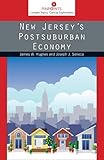New Jersey's Postsuburban Economy / Joseph Seneca, James W. Hughes.
Material type: TextSeries: PinpointsPublisher: New Brunswick, NJ : Rutgers University Press, [2014]Copyright date: ©2015Description: 1 online resource (154 p.) : 1 map, 3 figures, 22 tablesContent type:
TextSeries: PinpointsPublisher: New Brunswick, NJ : Rutgers University Press, [2014]Copyright date: ©2015Description: 1 online resource (154 p.) : 1 map, 3 figures, 22 tablesContent type: - 9780813570006
- 338.9749 23
- HC107.N5 H84 2014
- online - DeGruyter
| Item type | Current library | Call number | URL | Status | Notes | Barcode | |
|---|---|---|---|---|---|---|---|
 eBook
eBook
|
Biblioteca "Angelicum" Pont. Univ. S.Tommaso d'Aquino Nuvola online | online - DeGruyter (Browse shelf(Opens below)) | Online access | Not for loan (Accesso limitato) | Accesso per gli utenti autorizzati / Access for authorized users | (dgr)9780813570006 |
Browsing Biblioteca "Angelicum" Pont. Univ. S.Tommaso d'Aquino shelves, Shelving location: Nuvola online Close shelf browser (Hides shelf browser)

|

|

|

|

|

|

|
||
| online - DeGruyter The Methamphetamine Industry in America : Transnational Cartels and Local Entrepreneurs / | online - DeGruyter It's Not Your Fault! : Strategies for Solving Toilet Training and Bedwetting Problems / | online - DeGruyter Movie Migrations : Transnational Genre Flows and South Korean Cinema / | online - DeGruyter New Jersey's Postsuburban Economy / | online - DeGruyter Producing Excellence : The Making of Virtuosos / | online - DeGruyter In Lady Liberty's Shadow : The Politics of Race and Immigration in New Jersey / | online - DeGruyter The Autobiography of Citizenship : Assimilation and Resistance in U.S. Education / |
Frontmatter -- Contents -- List of Figures -- List of Tables -- Preface -- 1. Introduction and Overview -- 2. The Structure of the New Jersey Economy and the Business Cycle -- 3. The Broad Historical Evolution -- 4. Transportation and the Economy -- 5. The Wealth Belt -- 6. Demography, the Economy, and Housing -- 7. New Millennium, New Dynamics -- Notes -- About the authors
restricted access online access with authorization star
http://purl.org/coar/access_right/c_16ec
New Jersey has a long history of adapting to a changing economic climate. From its colonial origins to the present day, New Jersey's economy has continuously and successfully confronted the challenges and uncertainties of technological and demographic change, placing the state at the forefront of each national and global economic era. Based on James W. Hughes and Joseph J. Seneca’s nearly three-decade-long Rutgers Regional Report series, New Jersey’s Postsuburban Economy presents the issues confronting the state and brings to the forefront ideas for meeting these challenges. From the rural agricultural and natural resource based economy and lifestyle of the seventeenth century to today’s postindustrial, suburban-dominated, automobile-dependent economy, the economic drivers which were considered to be an asset are now viewed by many to be the state’s greatest disadvantage. On the brink of yet another transformation, this one driven by a new technology and an internet based global economy, New Jersey will have to adapt itself yet again—this time to a postsuburban digital economy. Hughes and Seneca describe the forces that are now propelling the state into yet another economic era. They do this in the context of historical economic transformations of New Jersey, setting out the technological, demographic, and transportation shifts that defined and drove them.
Mode of access: Internet via World Wide Web.
In English.
Description based on online resource; title from PDF title page (publisher's Web site, viewed 30. Aug 2021)


